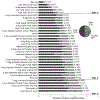Patellar Tendon Load Progression during Rehabilitation Exercises: Implications for the Treatment of Patellar Tendon Injuries
- PMID: 37847102
- PMCID: PMC10925836
- DOI: 10.1249/MSS.0000000000003323
Patellar Tendon Load Progression during Rehabilitation Exercises: Implications for the Treatment of Patellar Tendon Injuries
Abstract
Purpose: This study aimed to evaluate patellar tendon loading profiles (loading index, based on loading peak, loading impulse, and loading rate) of rehabilitation exercises to develop clinical guidelines to incrementally increase the rate and magnitude of patellar tendon loading during rehabilitation.
Methods: Twenty healthy adults (10 females/10 males, 25.9 ± 5.7 yr) performed 35 rehabilitation exercises, including different variations of squats, lunge, jumps, hops, landings, running, and sports specific tasks. Kinematic and kinetic data were collected, and a patellar tendon loading index was determined for each exercise using a weighted sum of loading peak, loading rate, and cumulative loading impulse. Then the exercises were ranked, according to the loading index, into tier 1 (loading index ≤0.33), tier 2 (0.33 < loading index <0.66), and tier 3 (loading index ≥0.66).
Results: The single-leg decline squat showed the highest loading index (0.747). Other tier 3 exercises included single-leg forward hop (0.666), single-leg countermovement jump (0.711), and running cut (0.725). The Spanish squat was categorized as a tier 2 exercise (0.563), as was running (0.612), double-leg countermovement jump (0.610), single-leg drop vertical jump (0.599), single-leg full squat (0.580), double-leg drop vertical jump (0.563), lunge (0.471), double-leg full squat (0.428), single-leg 60° squat (0.411), and Bulgarian squat (0.406). Tier 1 exercises included 20 cm step up (0.187), 20 cm step down (0.288), 30 cm step up (0.321), and double-leg 60° squat (0.224).
Conclusions: Three patellar tendon loading tiers were established based on a combination of loading peak, loading impulse, and loading rate. Clinicians may use these loading tiers as a guide to progressively increase patellar tendon loading during the rehabilitation of patients with patellar tendon disorders and after anterior cruciate ligament reconstruction using the bone-patellar tendon-bone graft.
Copyright © 2023 by the American College of Sports Medicine.
Conflict of interest statement
The authors acknowledge the National Institutes of Health (NIAMS R01AR078898, R01AR072034, and NICHD R37HD037985) for the financial support to this study. The authors have no conflicts of interest to declare.
Figures



References
-
- Lian OB, Engebretsen L, Bahr R. Prevalence of jumper’s knee among elite athletes from different sports: a cross-sectional study. Am J Sports Med. 2005;33(4):561–7. - PubMed
-
- Simpson M, Rio E, Cook J. At what age do children and adolescents develop lower limb tendon pathology or tendinopathy? A systematic review and meta-analysis. Sports Med. 2016;46(4):545–57. - PubMed
-
- Bergstrøm KA, Brandseth K, Fretheim S, Tvilde K, Ekeland A. Activity-related knee injuries and pain in athletic adolescents. Knee Surg Sports Traumatol Arthrosc. 2001;9(3):146–50. - PubMed
-
- Kettunen JA, Kvist M, Alanen E, Kujala UM. Long-term prognosis for Jumper’s Knee in male athletes: a prospective follow-up study. Am J Sports Med. 2002;30(5):689–92. - PubMed
-
- Hardy A, Casabianca L, Andrieu K, Baverel L, Noailles T. Complications following harvesting of patellar tendon or hamstring tendon grafts for anterior cruciate ligament reconstruction: systematic review of literature. Orthop Traumatol Surg Res. 2017;103(8):S245–8. - PubMed
MeSH terms
Grants and funding
LinkOut - more resources
Full Text Sources

